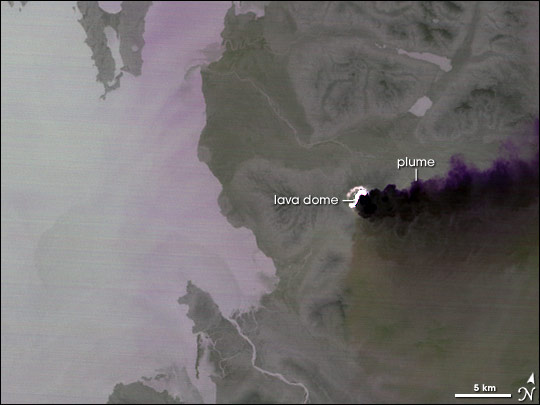


After its initial eruption on May 2, 2008, Chile’s Chaitén Volcano remained active in the days and weeks that followed, releasing a near-constant plume and blanketing the region in ash. On May 31, 2008, the Advanced Spaceborne Thermal Emission and Reflection Radiometer (ASTER) on NASA’s Terra satellite passed overhead and captured this image.
This false-color image was acquired at night, and it uses thermal radiation—light that our eyes cannot see, but which we can feel as heat—to make an image of the volcano and its surroundings. In this image, the lighter the color, the higher the temperature. Not surprisingly, the hottest area in this picture is at the lava dome in the volcano’s caldera. The slightly darker arc to the west may be the caldera rim. The purple-black plume blowing northeast from the summit is much colder.
Despite its cooler temperature, the volcanic plume can still pose serious hazards, namely from ash and sulfur dioxide. Unlike the soft, fluffy ash from burning vegetation, volcanic “ash” really consists of tiny jagged particles of rock and glass. Dangerous to breathe, volcanic ash also coats vegetation, both harming the plants and causing illness in herbivorous animals. Sulfur dioxide can combine with dust, water vapor, and other atmospheric gases to produce volcanic smog, or vog.
Chaitén is a caldera volcano. Calderas form when an explosive eruption completely empties the magma chamber beneath the volcano’s summit. The summit collapses into the empty chamber, creating a circular depression. As the volcano refills, a rounded lava dome may form in the caldera and may eventually rise above the caldera rim. Prior to its May 2008 eruption, Chaitén Volcano had been dormant for more than 9,000 years.
NASA image created by Jesse Allen, using data provided courtesy of GSFC/METI/ERSDAC/JAROS, and the U.S./Japan ASTER Science Team. Caption by Michon Scott.